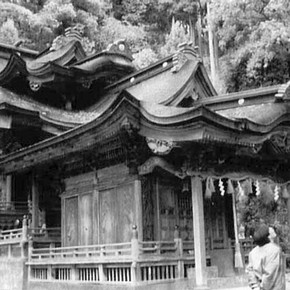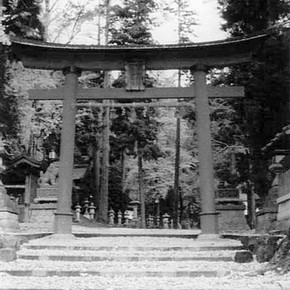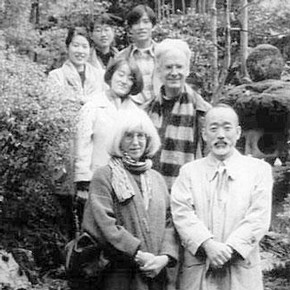Conservation Journal
July 1997 Issue 24
Painting in Japan
I am studying Japanese byobu and fusuma. These are the folding and sliding screens that were so important in Japanese life. My research will cover their history, and the papers and pigments used in their construction, paying particular attention to one of the conservation problems they present. This is the phenomenon of flaking and powdering of paint layers which often occurs.
The chance to spend time in Japan learning about the techniques and materials of traditional Japanese painting came in the first term of my second year of research. The Royal College of Art (RCA) and Kyoto City University of Art (KCUA or Geidai as it is known in Kyoto) operate a student exchange programme. Normally, this involves the exchange of fine art or design students. However, the relevance of the exchange to my own work was appreciated by both institutions and the scheme was extended to include me. I am grateful to Professor Frayling, now Rector of the RCA, for all his help.
Geidai does not have a conservation department (yet), but it gave me the chance to spend three months learning Nihonga mosha. That is copying classical Japanese scroll and screen paintings, an ancient tradition in Japan and also a way of prolonging the lifespan of a venerated painting. The opportunity to learn first hand the rudiments of the painting techniques and familiarise myself with the pigments and binders was immensely valuable to my research.
I tried to learn Japanese in the three months before my trip: this was spectacularly unsuccessful. When I arrived, the culture shock was unexpectedly real. I felt as though I had become deaf and dumb. I could not read signs or understand a word. I would board a bus and just hope for the best.
Life dropped to floor level: living, sleeping and working on the tatami mats, socks, no shoes. Eating was always an interesting excursion, sometimes not even being able to guess what I was chewing. But I did better than survive as the care and attention given to me by both students and tutors was generous and kind - unforgettable.
I thought that, having been a painter in the West, I would have the basic requirements needed to copy Japanese art. However, I had to learn to hold a brush, to size paper, to mix ink and to make paints from scratch, as none of the techniques were remotely like those I'd used before. It began with a trip, accompanied by my Professor, to colour merchants, where we sat for two hours choosing brushes, ink stick and stone, glue sticks and pigments which were weighed out by the gram, poured into glass phials and stoppered with paper lined corks.
I started with sumi-e, line drawing with black to grey ink. Without supporting arm or wrist, you guide the brush to make one stroke at a time, never going over a line a second time. I learned how to make the brush form particular marks and shapes. I copied from the Choju Jimbutsu Giga, a famous Heian period, twelfth century scroll from the Kozan ji Temple in Kyoto. A scroll of biting social comment where all the characters are frogs, rabbits and monkeys. I did wonder, at one point, what I was doing on a mountainside in Japan drawing pictures of rabbits, but I persisted and learned how to manipulate a brush enough to want to learn calligraphy one day.
After five sections of the Giga were completed, Miyamoto Sensei, my Professor, allowed me to use colour. Not too many to start with, just indigo, gamboge and benihana (a crimson extracted from safflower petals). These colours are bought as bo enogu sticks - pigments mixed with nikawa (animal glue) and dried. They are reconstituted by rubbing the end with water and finger tip and collecting the colour in a small white porcelain dish. With these colours I learned 'boneless' painting where the colour defines the edges without any lines. I copied a plant painting from a scroll by Maruyama Okyo (1733-95).
The making of gofun paint involved several days of instruction. Gofun is a white pigment made from ground, weathered oyster shells. If made with the correct proportion of nikawa it produces a glowing, almost luminous white, but can only be seen once it dries, as it is transparent when in solution. This means that many trials must be made to obtain the depth necessary before brushing thin layers onto a painting. Most important of all I learned to layer gofun and malachite using the finest particle size first, then to build up with coarser layers, some so coarse they wore out the brush. It is the gofun and malachite pigments which are most prone to powdering and flaking.
The studio group consisted of four students, the Professor and his assistant, Uno-san, and me. Sometimes an American professor of painting from Montana University joined us, giving me a chance to speak English. There were days out when the group visited scroll mounters, karakami printers, papermakers or karaoke dives. Most of these outings were for my benefit, but the painting students enjoyed this extension to their education. To visit two papermaking villages we stayed overnight at a Ryokan, a traditional Japanese inn, where we ate and bathed together. We visited Mino, in Gifu-Ken, where the finest paper in Japan is made, and met Saioka-san who made the paper we used in the studio. We also visited Imadate, in Fukui-Ken, and watched vast sheets (approx. 2000 x 1000 mm) of indigo dyed gampi paper being formed.
I managed to visit many of the hundreds of temples in Kyoto and Nara, on my own at the weekends, and on Fridays with the History of Art department. I was able to survey at first hand the problem of paint loss, which is widely evident.
The University is considering establishing a conservation school, and I hope my interest in the conservation of Japanese paint layers and papers was of use to them. I thank Miyamoto Sensei for all the information he gave me, I enjoyed my term in Kyoto very much, and hope to go back again one day.
Current Research
Back in England research is progressing in Paper Conservation into the consolidation of flaking and powdery matt gouache-type pigments on Japanese screens. A treatment has been developed for consolidant application which is less likely to disturb loose particles than application by brush, spray or air brush. Building on systems devised at the Canadian Conservation Institute and the Getty Conservation Institute, this simple method allows a consolidant to be introduced gradually, within a humidity chamber, causing little or no colour change.
The small, inexpensive, plastic nebuliser will deliver an ultrasonically produced mist from quite viscous liquids. Activated by a small air compressor, it is usefully mobile. Its potential in other areas of conservation is being explored, and further information will be available on completion of the research next year.
July 1997 Issue 24
- Editorial
- Managing to be 'Tackless'
- The Initial Conservation of an Archive of Rolled Architectural Drawings
- The Hand of God
- The Conservation of Nineteenth Century Dissected Puzzles
- Conservation and Mounting of Leaves from the Akbarnama
- The Coronation of the Virgin - a Technical Study
- Painting in Japan
- Printer Friendly Version


